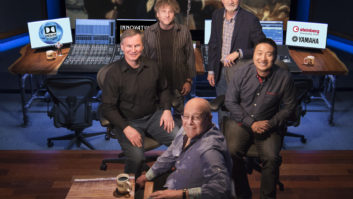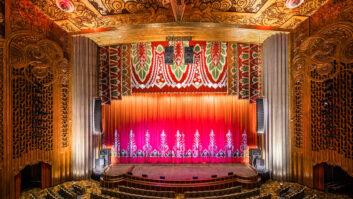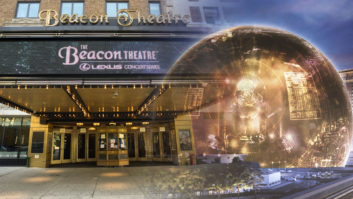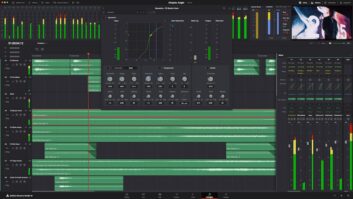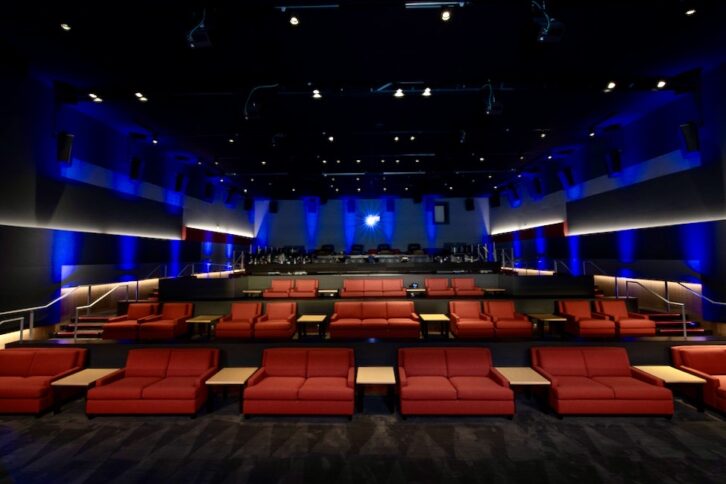
In Los Angeles, several major film and television studios have launched massive development projects in the last few years to expand and modernize their facilities. One of those studios, NBCUniversal, broke ground in 2020 on the Campus Project, a transformation of the Universal Studios Lower Lot (the Upper Lot is the theme park) at the company’s nearly 400-acre Universal City, Calif., site. The new campus, now in the final stages of construction, will include an 11-story, 350,000-square-foot office building, an 84,000-square-foot employee center, an eight-story parking garage and other amenities, interconnected by landscaped walkways and outdoor gathering spaces. The company has also opened eight new sound stages, bringing the total to 35 on the lot.
The campus has sprung up on a site that was previously home to a handful of buildings that included the Alfred Hitchcock Theatre, a sound mixing stage originally built in 1980. To continue the legacy of the legendary filmmaker, as well as what many considered to be one of the world’s best-sounding mix stages, NBCUniversal’s $1 billion master plan also funded construction of a new mixing stage bearing the Hitchcock name.
The new re-recording studio has been constructed in the shell of what was formerly Universal’s Sound Stage 6, a stone’s throw from the Hitchcock Theatre’s previous location. Built in the late 1930s, Stage 6 hosted some notable movie productions over the years, including Abbott & Costello Meet Frankenstein in 1948, Spartacus (1960), The Blues Brothers (1980) and Scarface (1983).
Thoma Thurau, Senior Vice President of NBCUniversal StudioPost, says that his department was pleased to be offered Stage 6 as the new home for the Hitchcock. “It’s a great spot because it’s adjacent to a lot of the other StudioPost sound buildings, not too far from the picture building and adjacent to our Avid editorial department—but it was not without considerable challenges to get it built.”
SOMETHING OLD, SOMETHING NEW
The project took just under 15 months, beginning in early 2020. Instead of using the more typical block-fill construction method, they used shotcrete, or sprayed concrete. “We tested it with our acoustician, who’s from the Salter Group, to ensure that it was going to give us the same isolation that block-fill does,” Thurau notes. “It shaved weeks and weeks off the job.”
To accommodate the height required for a multi-format, immersive monitor system, while also duplicating the original Hitchcock Theatre’s screen geometry, the construction team had to dig down by as much as 12 feet, shore up the foundations of the adjacent buildings, lay isolation slabs and reinforce Stage 6’s original frame to bear the loads imposed by a modern stage construction. The completed 80-by-56-foot room’s ceiling height is 23 feet at the 45-by-18-foot screen.
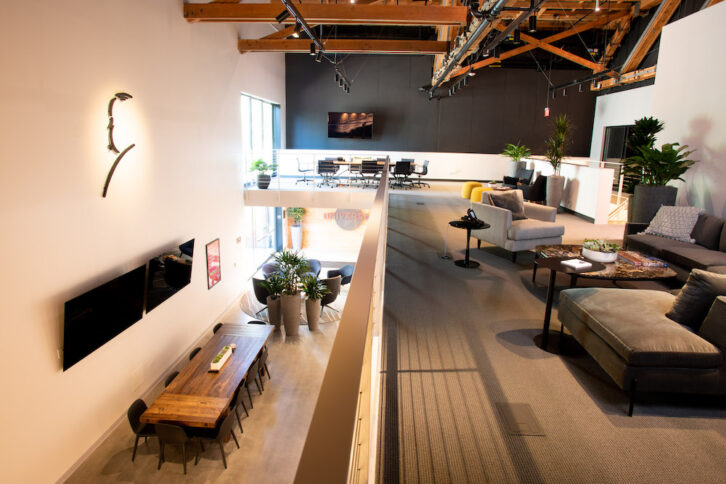
“This was built from the inside out, keeping the 1938 skeleton of Stage 6, which in the long run, I think, is probably more aesthetically pleasing, and keeps some of the history of its original function,” Thurau says.
The 90-year-old building’s history is on display as a decorative wall of wood reclaimed from Stage 6. More salvaged wood was used to build the stairs to the second floor. A stylized silhouette of Alfred Hitchcock, handcrafted on the lot in 1983 for the original theater, has been rehung on the new lobby wall.
Further, Thurau says, while the old Hitchcock was a theater, complete with rows of stadium seating, the new location was custom-built for its intended purpose: “It’s truly a mix stage, versus a theater turned into a mix stage.”
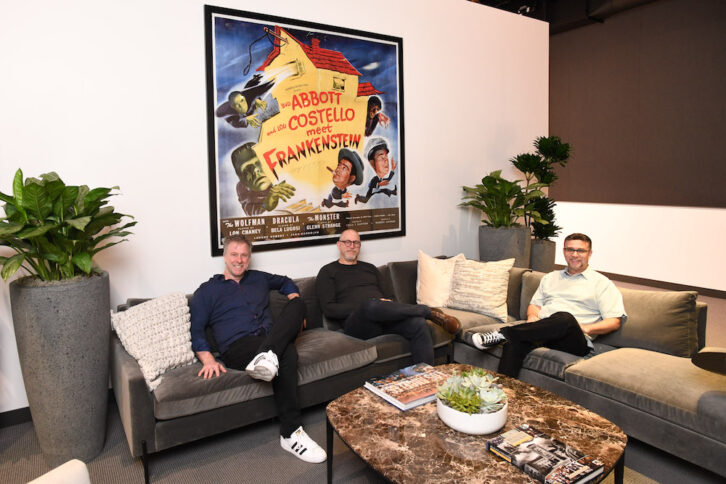
“The one thing essential to making it versatile was to not have theater seats; that gave us a lot more room,” adds Frank A. Montano, one-half—alongside Jon Taylor—of the award-winning, two-man, re-recording mix team that relocated to the new Hitchcock stage (Taylor mixes dialog and music; Montano handles sound effects). Montano reports that he and Taylor were consulted regarding not just technical but also architectural choices during the initial stages of the project. “We got to put our two cents in early,” he says.
MODERN TECHNOLOGY BACKBONE
Hitchcock Mixing Stage 6, its official full name, offers separate playback, recorder and picture workstations and features a 96-fader, dual-operator Avid S6 console system. Taylor recalls that he first used the S6, temporarily perched atop one of Universal’s Harrison MPC consoles, on a project with more than 600 music tracks. “The music was going to be evolving to the final, so I had no choice but to start everything on it. After the first hour, I said, ‘I love this thing. Can we just go ahead and put it in permanently?’”
For monitoring, the team elected to go with a Meyer Sound cinema system, a departure from their previous JBL-based system. “We were both introduced to the Meyer HD in 1997 or ’98,” Taylor says, adding that a few years prior to auditioning speakers for the new Hitchcock, they arranged a demo of Meyer Sound’s Bluehorn system. “Phase alignment was absolutely perfect. Anything out of phase would go right behind your head—and you realize you can’t do that on a normal setup. I ended up buying Meyer speakers for home before we did this room.”
The new monitor system, which supports Auro and IMAX formats, as well as Dolby Atmos, includes a combination of Meyer Sound’s Acheron and HMS Cinema Sound series speakers with a total of eight USW and X Series subs, plus an Ultra X42 for the IMAX VOG channel. “They represent the material very well,” says Montano, who reports that he and Taylor solicited opinions from their mixing colleagues in addition to auditioning the speakers. The consensus was that Meyer Sound speakers are transparent and revealing. “That’s a big benefit,” he adds. “We can hear and rectify any issues before they go beyond the stage.”
In-house senior engineer Joe Birkman tuned the room, Montano continues. “He was done in a couple of hours. It’s normally a handful of days. They were really tight, right out of the box. Plus, acoustically, this room is fantastic; it translates great.”
When the original Hitchcock was built, its acoustics represented the state of then-current cinema design, which was quite bright and reflective. “When Atmos theaters started being built, they were generally much more dead,” Montano explains. “They didn’t have all that drywall and hard surfaces. So we have to be more like the newer theaters.
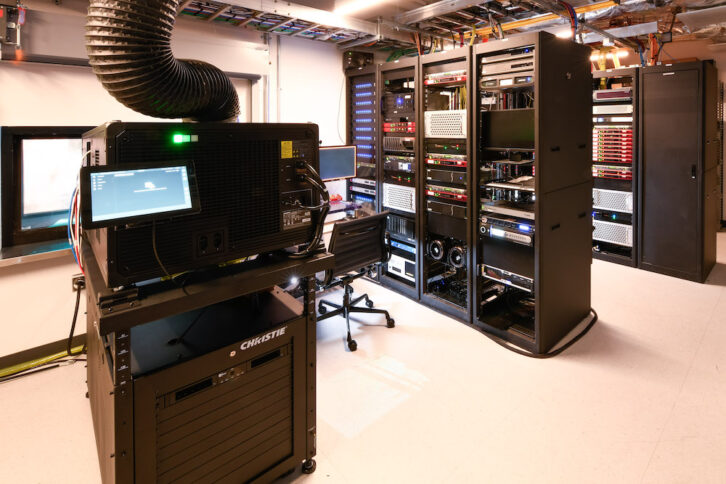
“We’re also fortunate to have a great projector,” he adds, noting the Christie CP 4440 4K. The resulting picture is a quantum leap from the days when mixers had to work from a black-and-white dupe or, later, a Quicktime copy. “If it looks really good, it’s going to sound better, and vice versa,” Montano laughs, “but that said, schedules are so tight now that filmmakers are doing everything at once: color timing, checking sound, VFX.”
Taylor agrees that the quality and accuracy of the projector on the mixing stage has taken the focus away from the picture and put it back on the audio. “Not having anybody comment in a negative way on the picture since we started in this room has been amazing,” he says, with a sense of relief. “Now we can concentrate on the sound.”
WORKING AS A TEAM
Taylor and Montano became an unofficial mix team in January 2013, having worked together on Fast Five a couple of years earlier. Their work together has garnered numerous accolades, including four Oscar nominations, for Unbroken, Birdman, The Revenant and First Man. They won BAFTA and CAS Awards for 2016’s The Revenant and a CAS Award earlier this year for Guillermo del Toro’s Pinocchio. Montano has five additional Oscar nominations dating back to 1993.
“We have a lot of things in common, so it was just a natural thing,” Montano says of their working relationship. “Our mixing styles fit really well, without even talking about it. There’s a shorthand. You hear something and just know that we’re on the same page. Dialog, music and sound effects all share the same frequencies, so it’s all about storytelling and give and take. And there’s no ego about it.”
“You can’t sit here and drown the music and call it a good mix, so there always has to be those handoffs,” Taylor chimes in. “Frankie will just give a little nudge to this one thing, and I’ll be like, ‘Okay, I’ll just drop this down here,’ or vice versa.”
For Taylor, working as a team is all about efficiency, but he now thinks about it differently. “I used to think of efficiency as a way of saving the clients’ money, but now what we care about is making sure we get the time that we need to get the quality that we want to achieve. That’s where efficiency is.”
They can’t both work at the same time, Taylor points out. “We take turns. While Frankie is listening to the monitors, I’ll be in the headphones, taking care of consonants or reverbs or cleaning up, or whatever I can do.”
At the same time, Bill Meadows, in-house mix tech and a 32-year veteran at Universal, keeps everything running smoothly on the Hitchcock stage. “We count on Bill to keep us straight. We’re blessed to be here and to work in this environment together,” Montano says.
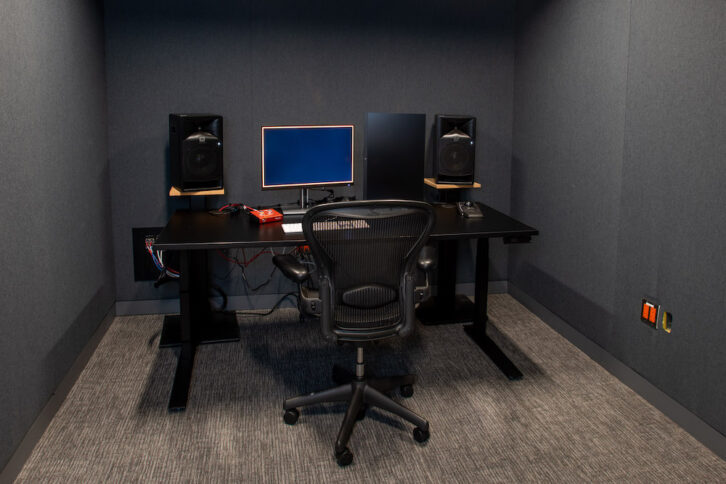
There are four editorial suites immediately behind the stage, one of which is outfitted for nearfield mastering with an Avid S1 and Meyer Sound Amie and UP-4slim speakers. Any of the suites can play back directly onto the stage or vice versa.
In fact, lot-wide fiber connectivity means that virtually any sound department room can access any other, explains Michael Morongell, Supervising Engineer, NBCUniversal StudioPost.
He adds, “We’re pretty much an all-Dante facility.” A peek into the Hitchcock stage’s machine room confirms that the racks are stacked with Focusrite RedNet Dante-capable equipment. Some rooms on the lot still use older audio technology, but once the planned upgrades are implemented, he says, “We’ll have complete interchangeability.”
Morongell and his group are responsible for, among many other things, a production network with extremely secure mass storage that is shared across the lot and a satellite network for synchronization, as well as the Dante shared audio network. The lot’s KVM network enables the engineering department to remotely service and troubleshoot.
VERSATILE, OPEN-PLAN FACILITY
Having worked in dark rooms for much of their careers, the mix team wanted as much natural light as possible in their new home.
“The concept was also to keep the open-air feel,” Montano says, pointing overhead in the lobby to the exposed wooden joists and trusses of the original building. “And as many windows as we could get,” he adds. A sliding wall of glass by the upstairs conference area—the table is also made from reclaimed wood—looks down onto the Paseo, one of the campus’ main walkways.
In addition to the spacious lobby, conference area and edit bays, the building also offers upstairs and downstairs kitchens, and an executive office for visiting directors, producers and the like. “The whole space is versatile,” Montano says. “The concept was to make it filmmaker-friendly, however they choose to use the space.”
‘White House Plumbers’ Panel Added to Mix Presents Sound for Film & Television
In the same way that a motion picture is a collaborative effort, Hitchcock Mixing Stage 6 was also all about teamwork. “We’ve got a great team; that’s what makes it fun,” Morongell says of his engineering group, some members of which he’s known for 30 years. He also worked closely with Jose Castellon, Manager, Studio and Cinema Design at Dolby Labs, and Miles Rogers, at the time Meyer Sound’s EXP Applications Development Manager.
“We get a lot of support from NBCUniversal, all the way up through Comcast,” says Thurau. “They see the value and the service that we bring to our internal as well as external customers. That support is great to have—especially nowadays, during these trying economic times, being able to continue to modernize and stay relevant in a very capital-challenged and margin-challenged business. Being able to continue to excel is great.”
AN ASIDE OF THANKS
Re-recording mixers Frank A. Montano and Jon Taylor recognize that they sit in the mix chairs and get to hear all the accolades regarding the new studio from those who bring in the projects. They also are effusive in their praise and thanks for the support throughout the process from the entire NBCUniversal team, including: Donna Langley, Chairman & Chief Content Officer, NBCUniversal Studio Group; Jimmy Horowitz, Vice Chairman, NBCUniversal Business Affairs & Operations; Ian Trombley, President, NBCUniversal Operations & Technology; Michael Moore, President & General Manager, Universal Studios; Thoma Thurau, Senior Vice President, NBCUniversal StudioPost; Michael Morongell, Supervising Engineer, NBCUniversal StudioPost; and the entire NBCUniversal StudioPost engineering team.
